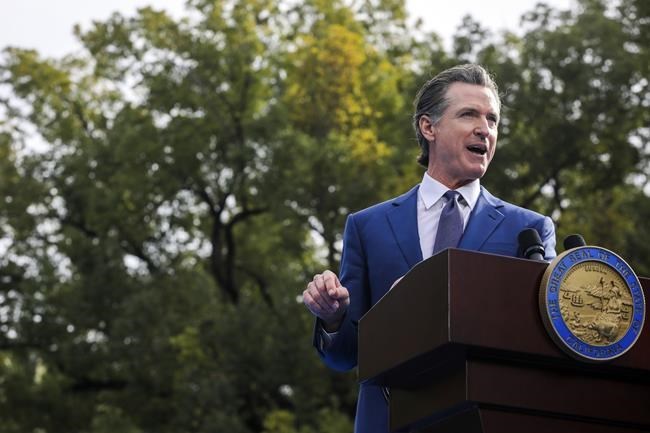SACRAMENTO, Calif. (AP) ŌĆö California faces a projected budget deficit of $22.5 billion for the coming fiscal year, Gov. Gavin ▀Ż─╠╔ńŪ°om announced Tuesday, just days into his second term. ItŌĆÖs a sharp turnaround from last yearŌĆÖs surplus.
The deficit, , could signal the end of a decadeŌĆÖs worth of economic growth in the nationŌĆÖs most populous state.
▀Ż─╠╔ńŪ°om, a Democrat, is proposing to close the hole by delaying spending in some areas and changing how others are funded. His budget appears to avoid significant cuts to most major programs, although it does lower proposed spending on climate change initiatives by about $6 billion. The state hopes to restore that spending in 2024 or offset it with federal money.
Among his climate maneuvers: HeŌĆÖll shift $4.3 billon in spending on zero-emission vehicles from the stateŌĆÖs taxpayer-funded general fund to a special fund paid into by polluters. HeŌĆÖs also delaying by a year $3.1 billion in climate and transportation funding.
The state still has about $35.6 billion in reserves.
▀Ż─╠╔ńŪ°om stressed that California would continue robust spending in public and higher education, climate change, health care, and responding to drought and wildfire.
ŌĆ£We're keeping our promises,ŌĆØ he said.
▀Ż─╠╔ńŪ°om's presentation offers the first glimpse of his spending and policy priorities as he launches his second term, but it's not the final say on how the state will dole out money. He'll reassess the state's finances in May after tax revenue has come in, and he'll sign a final budget in June.
The California Republican Party quickly blasted the proposal, saying ▀Ż─╠╔ńŪ°om has for years failed to adequately tackle issues like homelessness and wildfires despite record spending.
ŌĆ£Now with a massive budget shortfall projected, itŌĆÖs time for Gavin ▀Ż─╠╔ńŪ°om to finally get serious about smarter spending to resolve the many issues that are plaguing our state and driving long-time residents away,ŌĆØ party Chairwoman Jessica Millan Patterson said in a statement.
▀Ż─╠╔ńŪ°om's proposed cuts to climate spending, including in programs designed to boost zero-emission vehicles, drew criticism from some of his traditional environmental allies. The budget reduces hundreds of millions in spending on programs to expand zero-emission vehicle infrastructure in low-income neighborhoods and to transition delivery trucks, airplanes, rail lines and other transportation sources away from greenhouse gases.
ŌĆ£Investing in climate solutions is the only way to ensure a better California for all who live here,ŌĆØ said David Weiskopf, senior policy adviser for the climate group NextGen California.
His proposed budget isn't all cuts ŌĆö ▀Ż─╠╔ńŪ°om wants to give an additional $1 billion to local governments to combat homelessness, although he wants more accountability from local leaders. In the fall, he threatened to withhold funding for such programs. He's also proposed spending more on cash assistance programs for low-income and disabled Californians.
Other ways he's closing the spending hole including pulling back on $3 billion designed to help the state deal with inflation.
▀Ż─╠╔ńŪ°om has been warning of a potential budget shortfall for more than a year, and the Legislative AnalystŌĆÖs Office said in November the shortfall could be around $25 billion.
In September, ▀Ż─╠╔ńŪ°om publicly scolded lawmakers for sending him dozens of bills that, when added together, would have allowed billions in new spending. ▀Ż─╠╔ńŪ°om vetoed those bills, saying he has ŌĆ£made it crystal clear that we are seeing economic headwinds.ŌĆØ
Dealing with a deficit will be a change of pace for the state, where spending has more than doubled in the 10 years since the last recession. Officials have launched a dizzying amount of new programs and services ŌĆö including committing to pay for all 4-year-olds to go to kindergarten and agreeing to cover the health expenses of all low-income immigrants who are living in the country without legal permission.
The money has come mostly from a soaring stock market that launched a parade of California-based tech companies. Those companies ŌĆö including the likes of Uber, Airbnb, Lyft and Pinterest ŌĆö made lots of people very rich, creating a new class of millionaires and billionaires in a state with a progressive tax code where nearly half of all income taxes come from the top 1% of earners.
Sine then, lots of economic factors ŌĆö led by runaway inflation, supply chain disruptions and RussiaŌĆÖs invasion of Ukraine ŌĆö have had a chilling effect on the economy. The S&P 500, a key indicator of the health of U.S. stock markets, has fallen more than 18% since its peak at the end of 2021.
With rich people not making as much money, they are paying less in California state taxes. So far this year, CaliforniaŌĆÖs tax revenues have been $4.6 billion below expectations ŌĆö not including some one-time corporate tax payments that state officials say they canŌĆÖt count on.
Money from capital gains taxes is projected to be about 5.5% of the state's revenue, down from 9.75% last year, ▀Ż─╠╔ńŪ°om said.
Still, California appears to be well-positioned to weather an economic downturn. Of the $131 billion in general fund surpluses the state has had in the past four years, most of it ŌĆö about $80 billion ŌĆö has paid for things that do not require ongoing funding, like construction projects. Just $10 billion of surplus spending has paid for ongoing commitments, according to the Legislative AnalystŌĆÖs Office.
Constitutional limits prevent lawmakers from emptying reserves to cover a deficit. And unlike the federal government, CaliforniaŌĆÖs budget must be balanced. ▀Ż─╠╔ńŪ°om and lawmakers will have to tighten state spending to cover all of the shortfall ŌĆö something that Senate Budget Committee chair Nancy Skinner said is doable.
ŌĆ£We funded things at such record levels, and a lot of the programs that we funded havenŌĆÖt even gotten going yet, so we still have room to make some adjustments if needed,ŌĆØ she said. ŌĆ£IŌĆÖm very optimistic because weŌĆÖre in good shape.ŌĆØ
Adam Beam, The Associated Press




